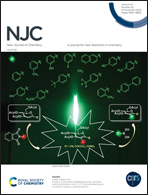Low Pt loaded CNTs as efficient catalysts for CO oxidation†
Abstract
Four types of Pt/C catalysts were synthesized by depositing platinum on various carbon materials, including graphene, graphitic carbon nitride, activated carbon, and carbon nanotubes. The microscopic structure and physicochemical properties of these catalysts were analyzed using different techniques such as TEM, XRD, BET, TGA, and XPS. The results indicated that platinum predominantly existed in the form of nanoparticles on graphene, graphitic carbon nitride, and carbon nanotubes. The performance of the catalysts in catalyzing CO oxidation was evaluated, and Pt/CNTs exhibited the highest efficiency compared to other catalysts. At a temperature of 170 °C, the conversion efficiency of CO on Pt/CNTs reached 96.5%. In situ DRIFTS experiments were performed, which did not show any peaks of CO adsorption on the surface of Pt/CNTs. Therefore, the oxidation of CO on Pt/CNTs was presumed to proceed via the Eley–Rideal (ER) mechanism. O2 was adsorbed and activated on Pt NPs to form a Pt NP–O–O*–CO structure with CO, which then decomposed to yield CO2 and an activated oxygen species (O*). Finally, O* reacted with CO again to produce CO2, completing the catalytic cycle.



 Please wait while we load your content...
Please wait while we load your content...